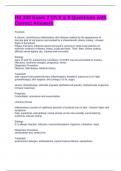HS 320 Exam 3 Ch 8 & 9 Questions with
Correct Answers
Psoriasis
A chronic, noninfecious inflammatory skin disease marked by the appearance of
discrete pink of red lesions surmounted by a characteristic silvery scaling - Answer-
Signs & Symptoms
Plague Psoriasis: inflamed raised red lesions covered in white scaly patches on
extensor surfaces of elbows, knees, scalp and back. Thick, flaky, silvery scaling;
affected areas appear dry, cracked and encrusted
Etiology
ages 15 and 50. autoimmune. hereditary. FLARES may be proceeded by trauma,
infections, hormone changes, pregnancy, stress
Diagnostic Procedure
Observe. Skin Biopsy. Medical history.
Treatment
mild: topical cortico(steroids-decr inflammation), emollient, exposure to UV light
(phototherapy), skin hygiene, diet (omega 3 & vit. supp)
severe: phototherapy, retinoids (regulate epithelial cell growth), methotrexate (suppress
immune response)
Prognosis
Controllable, remissions and exacerbation
Urticaria (Hives)
Inflammatory reaction of capillaries beneath a localized area of skin - Answer-Signs and
symptoms
Pale, superficial, well-defined, raised wheals on the skin possibly surrounded by
erythema, intense itching
Etiology
5 i's allergic reaction: Infection, insects/infestations, ingestion, inhalation, inject
Diagnostic Procedure
sensitization test, medical hx
Treatment
avoid known allergen, antihistamine, topical hydrocortisone, epinephrine
,Prognosis
Repeated=anaphylactic reaction
Acne Vulgaris
Inflammatory disease of sebaceous glands and hair follicles, character by comedones,
papules and pustules
Open=black Closed=white - Answer-Signs/ Symptoms
Rupture of the acne plug, inflammation and acne pustules; scars if chronic irritation
continues over time
Etiology
genetic, drugs, stress, hormones,occlusion/ pressure on skin. NOT caused by specific
foods
Diagnostic Procedure
Observe, medical history
Treatment
decr infection, sebaceous gland, inflammation. antibac on skin (BENZOYL PEROXIDE),
oral antibiotics
Rosacea
chronic inflammatory conditino that causes erythema, flushing and red pustules (no
comedones) - Answer-Signs/ Symptoms
(Snowboarding cold face) small red pustules
Phase 1: pre-rosacea - blush
Phase 2: vascular rosacea - sensitive skin and small vessels on cheeks and nose swell
Phase 3: inflammatory rosacea - pustules on face
Etiology
Genetic (white) & environmental
Diagnostic Procedures
Physical exam, medical hx
Treatment
decr inflammation w/ topical tretinoin, benzoyl peroxide and azelaic acid, oral antibiotic
(-cycline) Intense pulsed light/broad band light therapy, wear sunscreen, protect face,
no alcohol
Keratosis Pilaris
painless, skin-colored bumps that may redden and form rough patches of skin - Answer-
Sign/ Symptoms
, small, evenly spaced papules on upper arms, thighs, buttocks and face
Etiology
usually before age 10, worse with puberty
Diagnostic Procedures
Physical exam, dermatologist consultation
Treatment
removal of built up keratin, topical steriods
Alopecia Areata
Absence of hair
SCARRING alopecia-fibrosis, loss of hair follicles, inflammation
NON-SCARRING alopecia-hair shafts are gone but hair follicles are preserved -
Answer-Sign/ Symptoms
may occur gradually with advancing age or may be sudden
Etiology
abnormal immune response
Diagnostic Procedure
observe, health hx, exam skin/oral mucosa and biopsy
Treatment
SCARRING - no treatment
NON-SCARRING - mnoxxidil to treat male pattern baldness, surgical redistribution of
hair follicles
Folliculitis/ Faruncle/ Carbuncles
Folliculitis - infected hair follicle
Faruncle - abscess involving the entire hair follicle and adjacent subcutaneous tissue
Carbuncle - several furuncles developing in adjoining hair follicles with multiple drainage
sinuses - Answer-Signs/ Symptoms
Affected area may be painful, tender and swollen; abscess may enlarge, soften and
open discharging pus and necrotic material; erythema and edema may persist for days
or weeks
Etiology
Staphylococcal bacterial infection
Diagnostic Procedures
Made on basis of appearance of characteristic lesion; slight leukocytosis; gram stains of
purulent content reveal causative organism




